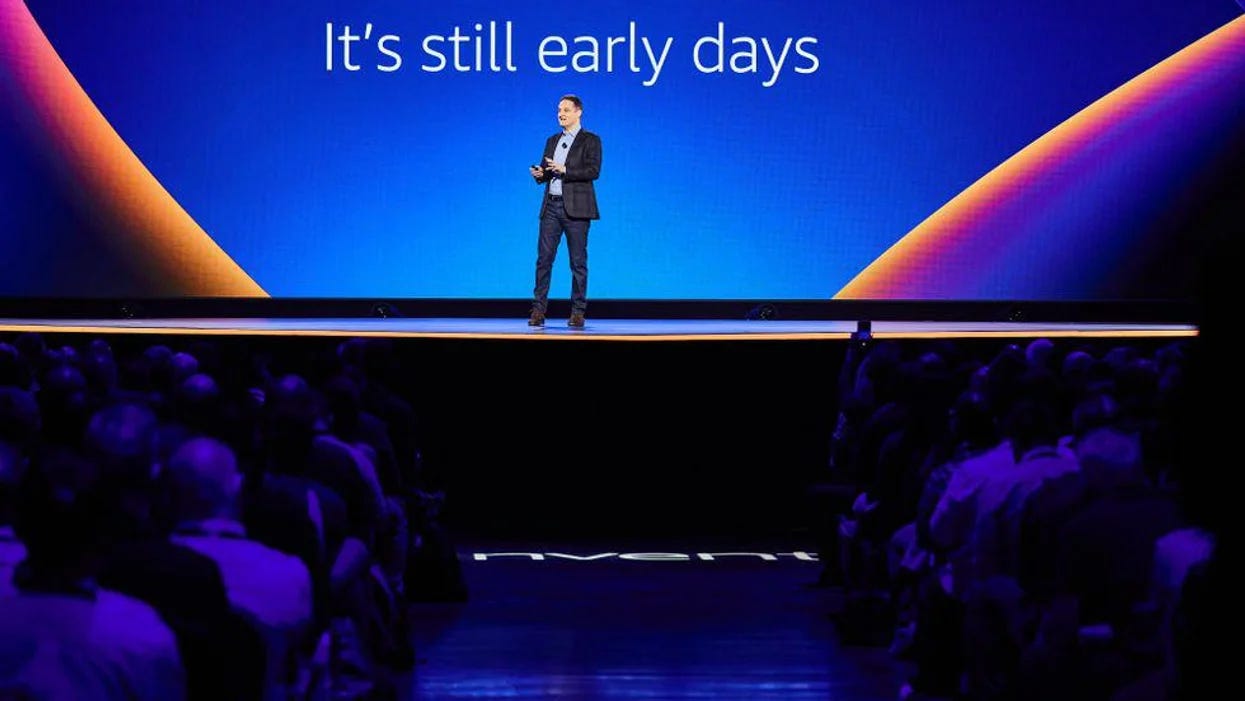AWS makes an AI move
ALL YOU NEED IS LOVE
Welcome to Mostly Cloudy! Today: why taking time to reveal its generative AI strategy might have done AWS a favor, why Oracle’s gonna Oracle, and some interesting thoughts about the future of infrastructure tech in 2023 and beyond.
Photo: AWS
Faceoff
During all the hype over Microsoft’s partnership with OpenAI, which has slowed to a noticeable trickle over the last week or so after it became clear Bing 2.0 was far from ready for prime time, Google was always the company seen as caught on its heels by the search-oriented AI hoopla. But the partnership spurred Microsoft to build out a serious collection of AI cloud hardware and services that can also be resold to enterprise customers, and that could be a problem for AWS.
This week AWS trotted out its own partnership with a budding generative AI company, although HuggingFace has received a fraction of the attention paid to OpenAI. The two companies will expand an existing partnership “to accelerate the availability of next-generation machine learning models by making them more accessible to the machine learning community and helping developers achieve the highest performance at the lowest cost,” according to HuggingFace.
While the reinvention of search around chatbots might have to wait a while, enterprise customers are interested in learning how generative AI technologies can help them make their operations more efficient. Cloud providers are also interested in selling AI services to those enterprises because of the high margins those services command, compared to the basics like compute and storage.
Under the expanded partnership, HuggingFace’s customers — who use the company’s tools to build machine-learning models — will be able to use AWS’s own AI development tools, such as SageMaker, to run those models on AWS. AWS customers will be able to use models developed by the HuggingFace community to supplement their own work, and according to the two companies, everyone will live happily ever after.
AWS has spent a ton of time talking up its own AI-related services and hardware investments over the last several years, but it’s not clear how many enterprise customers are actually using those tools. However, it’s going to take some time for winners and losers to emerge from among those hoping to sell the picks and shovels to AI Rush miners.
Right now lots of people want to compare AI, and specifically generative AI, to the iPhone as a breakthrough ready to shake up the current pecking order. But the iPhone emerged after companies like Nokia, RIM, and Palm showed early adopters the potential that smartphones could have. Unlike Apple, they failed to put the pieces together in a way that captured the hearts of regular people and software developers, and as a result, they’re lost to history.
In other words, the world was ready for a better smartphone when the iPhone came along, and nothing was never the same. The world isn’t ready for generative AI: Microsoft’s rushed introduction of the latest ChatGPT software, and the subsequent rollback of some key capabilities as non-engineers got their hands on it, shows we’re still in the BlackBerry era of this technology.
The iPhone moment is very much still up for grabs.
The more things change…
Gartner is warning enterprise customers that new licensing terms for Java SE could see Oracle eventually reaching out to those customers with a message equivalent to “nice apps, be a shame if something happened to them.”
Oracle introduced a new licensing program for Java SE in January, changing the pricing scheme for those licenses from a per-processor basis to a per-employee basis, which immediately set off warning bells. It said customers on legacy licenses “may renew under their existing terms and metrics,” but Gartner is not willing to take Oracle at its word for some reason.
The company "has a history of changing offerings and metrics across its entire product portfolio and generally not permitting long-term renewal and/or modifications to the legacy offerings," Gartner said in a research paper, according to The Register.
Countless numbers of enterprise apps were built with Java over the last two decades, and lots of companies are stuck supporting them for the foreseeable future. Extracting money from those companies was one of the primary reasons Oracle bought Sun Microsystems back in 2010, although you can thank the Supreme Court for limiting the damage.
Around the enterprise
Kleiner Perkins’ Bucky Moore had some interesting predictions for the year in infrastructure computing, including the durability of Javascript and the evolution of cloud data warehouse technology.
Dan Rogers is the new CEO of Launch Darkly, taking over for co-founder Edith Harbaugh, who will become executive chair.
Google Cloud employees are being introduced to a new definition of multitenant, after being asked to share desks at five major offices.
Nvidia’s data-center revenue grew 11% during the fourth quarter, and it teased the introduction of a new AI-oriented cloud service that it will provide more details on later this year.
Thanks for reading — see you next week!

